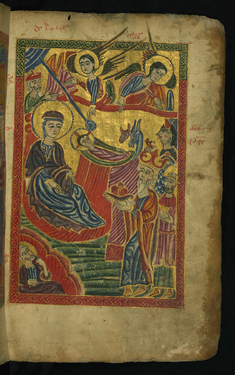Gospel Book
(Manuscripts and Rare Books)
This manuscript was executed in 1475 CE by a scribe identified as Aristakes for a priest named Hakob. It contains a series of sixteen images on the life of Christ preceding the text of the Gospels, as well as the traditional Evangelist portraits, and there are marginal illustrations throughout. The style of the miniatures, which employ brilliant colors and emphasize decorative patterns, is characteristic of manuscript production in the region around Lake Van during the fifteenth century. The style of Lake Van has often been described in relation to schools of Islamic arts of the book. Numerous inscriptions (on fols. 258-260) spanning a few centuries attest to the manuscript's long history of use and revered preservation. The codex's later history included a rebinding with silver covers from Kayseri that date to approximately 1700. This jeweled and enameled silver binding bears a composition of the Adoration of the Magi on the front and the Ascension on the back.
Provenance
Provenance (from the French provenir, 'to come from/forth') is the chronology of the ownership, custody, or location of a historical object. Learn more about provenance at the Walters.
Created by Aristakes for Priest Hakob, son of Umek and Hrip'sime, Armenia [possibly in the Lake Van Region, Türkiye], 1475 [1]. Mahdesi Elia, Erzerum, 1717, by purchase; Surb Parsan (St. Parsam), [DATE], Tokat, Türkiye, by gift [2]. Louis Froget, Lyons and Paris, France, by 1901, [mode of acquisition unknown] [3]; Henry Walters, Baltimore, MD, 1901, by purchase [George A. Lucas as agent]; Walters Art Museum, 1931, by bequest.
[1] Armenian patriarch, Karekin Hovsepian, identified the creation place as Tauris, Persia (modern Tabriz, Iran) in 1936.
[2] Undated ownership notices include: Ter Ghazar and sons Ter Abraham and Ter Hakob; Khodja Ghazar and Astvadsatur (who renewed and deposited the manuscript at the Church of the Holy Virgin [location unknown]); and Bishop Poghos, who rebound it with help from his son Hovannes Malaz.
[3] The precise location of this manuscript is unknown between 1751 and 1901, and it may have been removed from Armenian territory during the 19th-century Armenian massacres.
Exhibitions
| 2014-2016 | From Rye to Raphael: The Walters Story. The Walters Art Museum, Baltimore. |
| 2010-2011 | Beasts on Parchment: Picturing Animals in Medieval Manuscripts. The Walters Art Museum, Baltimore. |
| 2004 | Illuminating the Word: Gospel Books in the Middle Ages. The Walters Art Museum, Baltimore. |
| 1994 | Treasures in Heaven: Armenian Illuminated Manuscripts. The Morgan Library & Museum, New York; The Walters Art Gallery, Baltimore. |
| 1990-1991 | The Book and the Author: Portraits of the Evangelists in Eastern and Western Manuscripts. The Walters Art Gallery, Baltimore. |
| 1988 | Treasures in Heaven: Armenian Manuscript Illumination. The Walters Art Gallery, Baltimore. |
| 1984-1985 | Illuminated Manuscripts: Masterpieces in Miniature. The Walters Art Gallery, Baltimore. |
| 1957-1958 | The History of Bookbinding 525-1950 A.D.. Baltimore Museum of Art, Baltimore. |
| 1953-1957 | 4000 Years of Modern Art. The Walters Art Gallery, Baltimore; Baltimore Museum of Art, Baltimore. |
Conservation
| Date | Description | Narrative |
|---|---|---|
| 10/27/1981 | Examination | examined for condition |
| 6/14/2014 | Examination | examined for condition |
| 7/9/2014 | Treatment | Cleaned |
Geographies
Armenia (Place of Origin)
Measurements
Folio H: 10 1/4 × W: 6 11/16 in. (26 × 17 cm); Closed H: 10 11/16 × W: 7 5/8 × D: 3 3/16 in. (27.2 × 19.4 × 8.1 cm)
Credit Line
Acquired by Henry Walters before 1911
Location in Museum
Not on view
Accession Number
In libraries, galleries, museums, and archives, an accession number is a unique identifier assigned to each object in the collection.
In libraries, galleries, museums, and archives, an accession number is a unique identifier assigned to each object in the collection.
W.540



